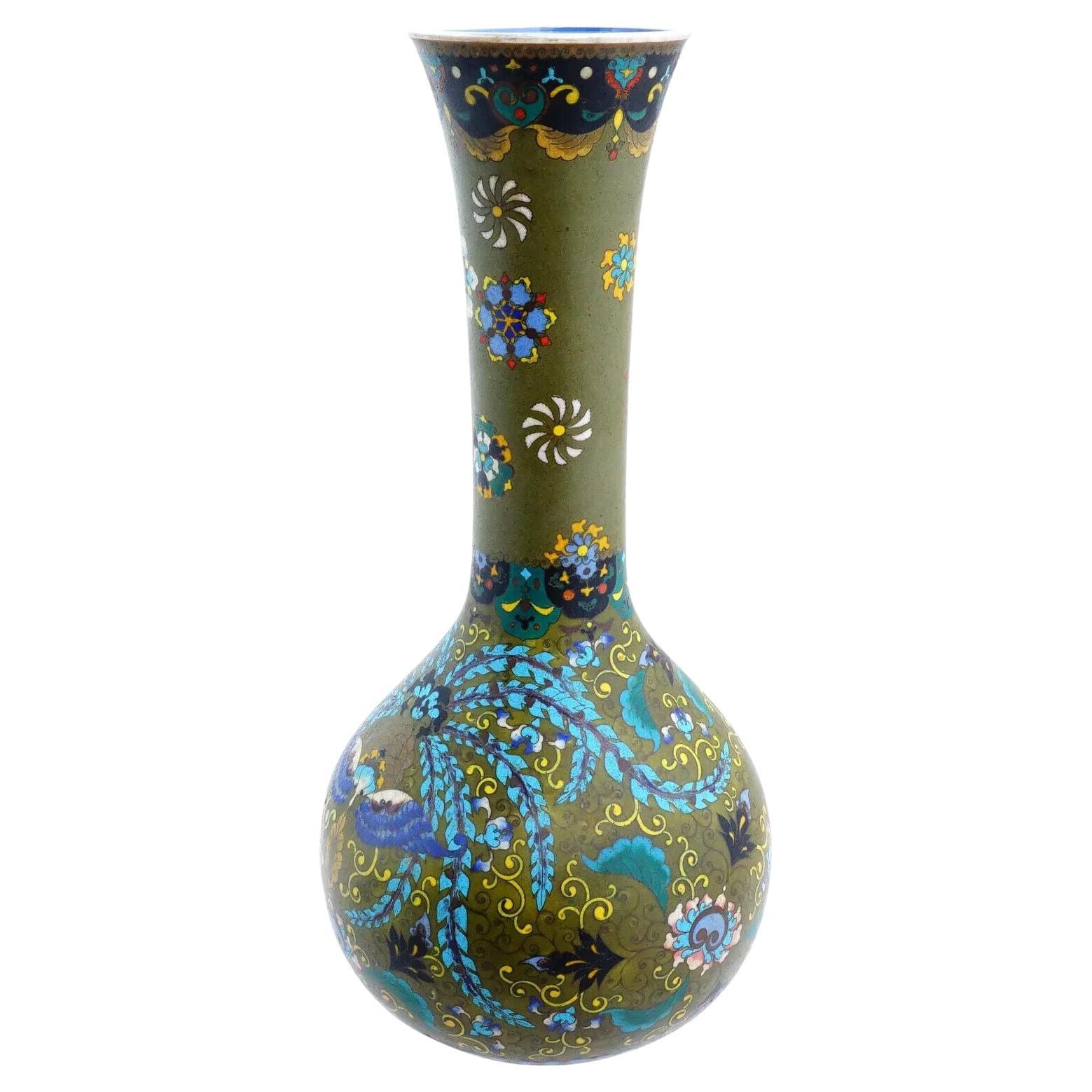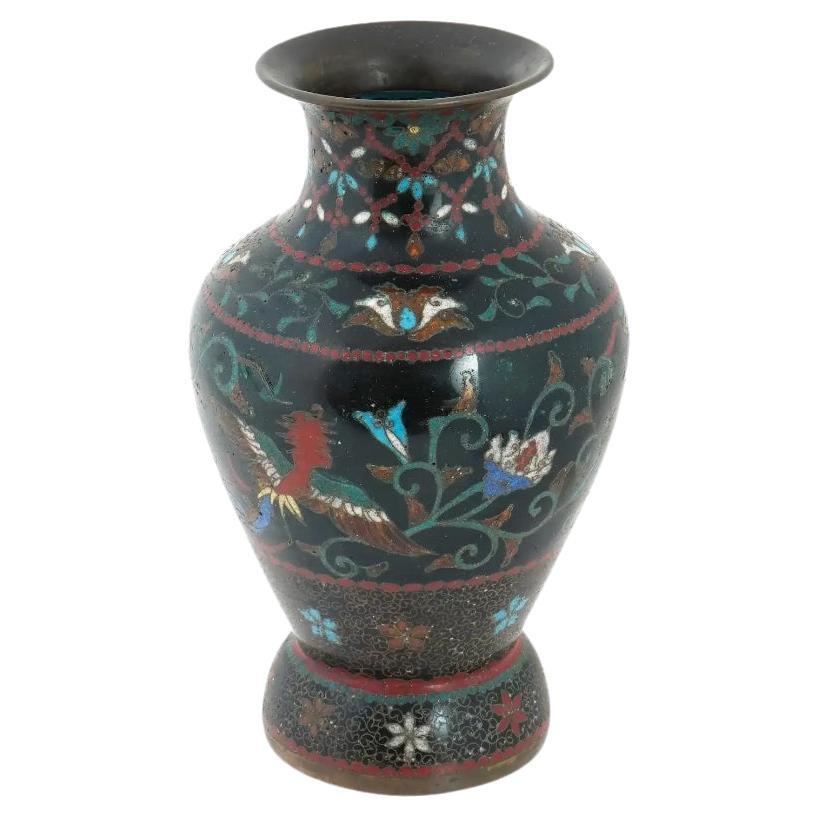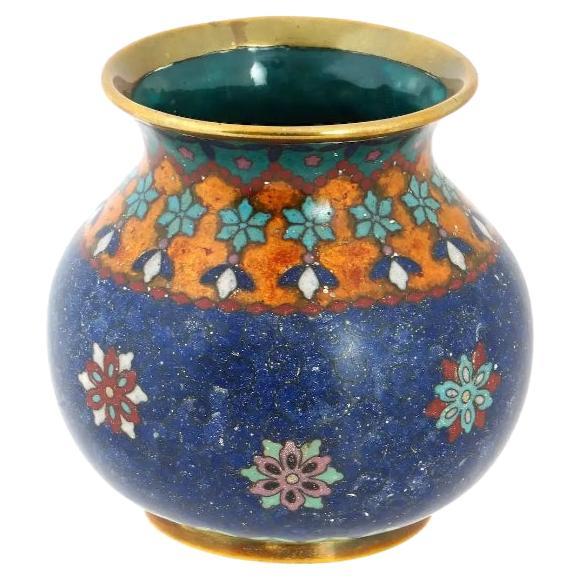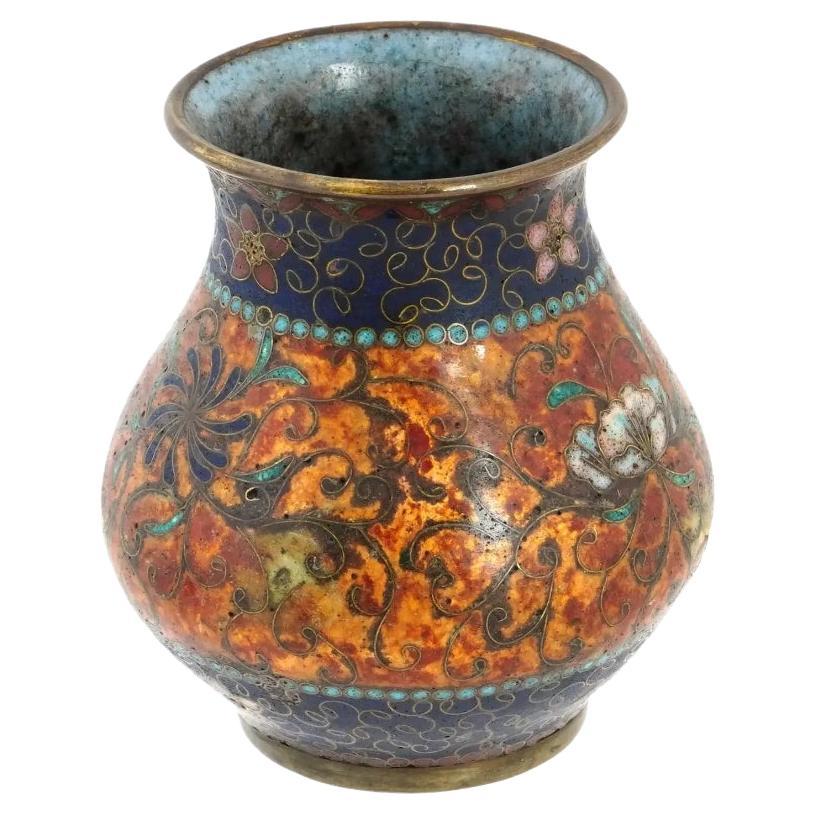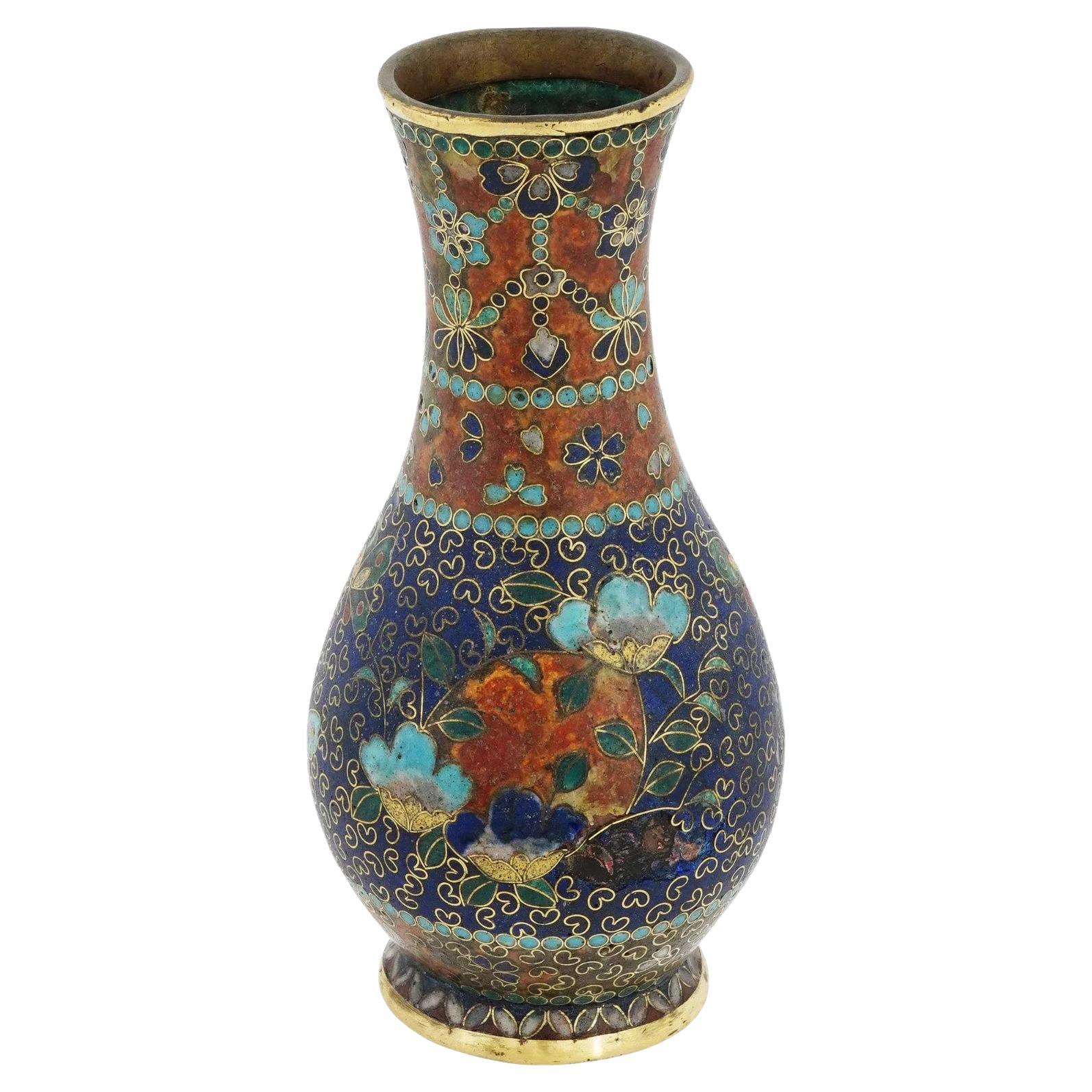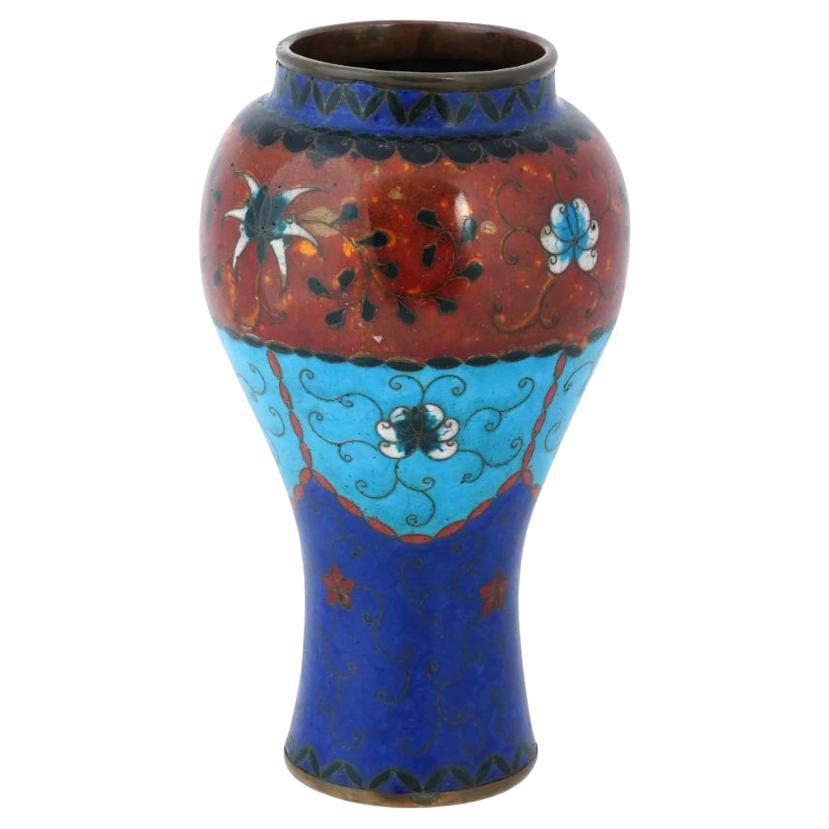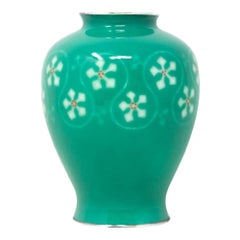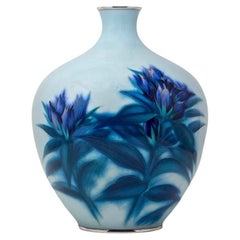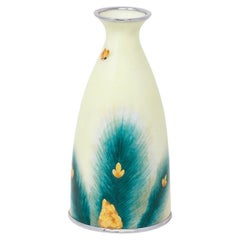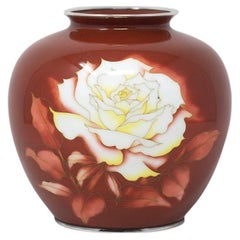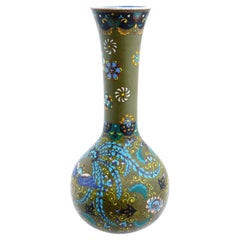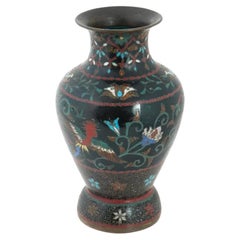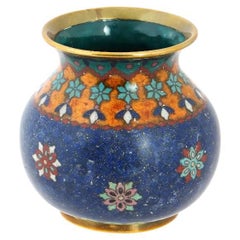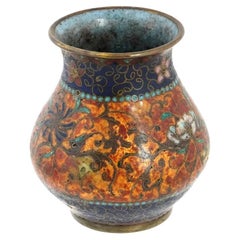Items Similar to Rare Japanese Meiji Period Moriage Cloisonne Enamel Vase
Want more images or videos?
Request additional images or videos from the seller
1 of 21
Rare Japanese Meiji Period Moriage Cloisonne Enamel Vase
$7,241.57
£5,250
€6,177.76
CA$10,021.24
A$11,158.04
CHF 5,806.42
MX$134,675.37
NOK 72,817.92
SEK 68,781.11
DKK 46,121.53
About the Item
Very Rare Moriage Netting
From our Japanese collection, we are thrilled to introduce this fine Japanese Moriage Cloisonne Enamel Vase. The Cloisonne Enamel Vase of baluster form with large waisted body and bulbous neck is beautifully formed with a ginbari sky blue base intricately decorated with three silver wired polychrome birds in mid flight. The Cloisonne Enamel Vase is finished with silver mounts and a rare moriage raised white enamel fish netting to the exterior. The piled moriage enamel fish netting is a rare and complex addition to the vase one which takes a highly skilled craftsman to execute adding to its fine finish. The Japanese Moriage Cloisonne Enamel Vase dates to the Meiji Period (1868-1912) circa 1910.
Ginbari is a type of cloisonne enamel with clear enamel over a stippled silver layer applied to the sheet body.
Moriage is a meticulous technique that involves layering enamel to create a three-dimensional effect. The term “Moriage” also refers to slip or colored clay string decoration, commonly seen on Japanese porcelain. This method, which resembles ‘cake frosting,’ uses diluted clay to achieve a textured, raised surface. It was produced in Japan from the late 1800s to the mid-1900s, reflecting Western interest in exotic art during the late 19th century.
Cloisonne is a technique of decorating metalwork objects with coloured material separated by wire often made from precious metals. In the first instance the decoration is formed by creating a stencil on the metal object by affixing wires to the surface which will be visible once the product is finished allowing the artisan to craft beautiful scenes such as blossoming flowers or mythical animals by filling in the spaces with various colours.
Enamel (vitreous enamel) also known as porcelain enamel, is a material made by fusing powdered glass to a substrate by firing, usually between 750 and 850 °C. The powder melts, flows, and then hardens to a smooth, durable vitreous coating. The word vitreous comes from the Latin vitreous, meaning “glassy”.
Meiji Period was an era of Japanese history that spanned from 1868 to 1912. It was the first half of the Empire of Japan, when the Japanese people began to build a paradigm of a modern, industrialised nation state and emergent great power, influenced by Western countries and aesthetics. As a result of radically different ideas, the changes to Japan were profound and it affected the social structure, politics, economy, military, and foreign relations across the board. The period corresponded to the reign of Emperor Meiji and was preceded by the Keio era and was succeeded by the Taisho era.
Cultural Art during the Meiji Period was of particular interest to the government and they overhauled the art export market which in turn promoted Japanese arts via various world’s fairs, beginning in Vienna at the world fair in 1873. The government heavily funded the fairs and took an active role organising how Japan’s culture was presented to the world including creating a semi-public company named Kiritsu Kosho Kaisha (First Industrial Manufacturing Company). The Kiritsu Kosho Kaisha was used to promote and commercialise exports of Japanese art and established the Hakurankai Jimukyoku (Exhibition Bureau) to maintain quality standards. For the 1876 Centennial International Exhibition in Philadelphia, the Japanese government created a Centennial Office and sent a special envoy to secure space for the 30,000 items that would be displayed. The Imperial Household also took an active interest in arts and crafts, commissioning works by select artists to be given as gifts for foreign dignitaries further emphasising the high quality and importance of Japanese art. Just before the end of the 19th century in 1890, the Teishitsu Gigeiin (Artist to the Imperial Household) system was created to recognise distinguished artists. These artists were selected for their exceptionally high quality wares and talent in their own industry. Over a period of 54 years Seventy artists were appointed, amongst these were ceramicist Makuzu Kozan and cloisonné enamel artist Namikawa Yasuyuki.
- Dimensions:Height: 4.73 in (12 cm)Diameter: 3.55 in (9 cm)
- Style:Meiji (Of the Period)
- Materials and Techniques:
- Place of Origin:
- Period:1910-1919
- Date of Manufacture:Circa 1910
- Condition:Small hairline to the bottom rim, one above the wing of the bird, very difficult to see through the clear enamel, otherwise excellent. Ginbari is noted for its highly fragile nature and it is extremely rare to fine pieces in perfect condition.
- Seller Location:Newark, GB
- Reference Number:Seller: BKWDD1stDibs: LU6971242114552
About the Seller
5.0
Gold Seller
Premium sellers maintaining a 4.3+ rating and 24-hour response times
Established in 2019
1stDibs seller since 2022
37 sales on 1stDibs
Typical response time: 2 hours
- ShippingRetrieving quote...Shipping from: Newark, United Kingdom
- Return Policy
Authenticity Guarantee
In the unlikely event there’s an issue with an item’s authenticity, contact us within 1 year for a full refund. DetailsMoney-Back Guarantee
If your item is not as described, is damaged in transit, or does not arrive, contact us within 7 days for a full refund. Details24-Hour Cancellation
You have a 24-hour grace period in which to reconsider your purchase, with no questions asked.Vetted Professional Sellers
Our world-class sellers must adhere to strict standards for service and quality, maintaining the integrity of our listings.Price-Match Guarantee
If you find that a seller listed the same item for a lower price elsewhere, we’ll match it.Trusted Global Delivery
Our best-in-class carrier network provides specialized shipping options worldwide, including custom delivery.More From This Seller
View AllJapanese Wireless Cloisonne Enamel Vase by the Ando Company
By Ando Jubei
Located in Newark, England
Art Deco
From our Japanese collection, we are delighted to offer this Japanese Cloisonne Enamel Vase by the Ando Company. The Cloisonne Enamel Vase of globular form decorated in a m...
Category
Mid-20th Century Japanese Art Deco Vases
Materials
Silver, Enamel
Japanese Cloisonné Enamel Vase by Ando Company, Showa Period
By Ando Jubei
Located in Newark, England
Striking Blue Cloisonne Enamel Vase
From our Japanese collection, we’re pleased to offer this cloisonné enamel vase by the Ando Company, dating to the late Showa period, circa 1945....
Category
Mid-20th Century Japanese Showa Vases
Materials
Silver, Enamel
Contemporary Japanese Cloisonne Enamel Vase Tamura
By Tamura
Located in Newark, England
Showa Period Circa 1940
From our Japanese collection, we are pleased to offer this Antique Japanese Cloisonne Enamel Vase by Tamura. The vase of tapered cylindrical form with a tigh...
Category
Mid-20th Century Japanese Showa Vases
Materials
Enamel, Metallic Thread
Japanese Cloisonne Enamel Vase by the Ando Company
By Ando Jubei
Located in Newark, England
White Rose
From our Japanese collection, we are delighted to offer this Japanese Cloisonne Enamel Vase by the Ando Company. The Cloisonne Enamel vase of globular form with a tightly...
Category
Mid-20th Century Japanese Art Deco Vases
Materials
Silver, Enamel
Japanese Meiji Period Cloisonne Enamel Vase by Ando Jubei
By Ando Jubei
Located in Newark, England
Free international shipping
Ando Cloisonne Company Mark
From our Japanese collection, we are delighted to introduce this Japanese Cloisonne Enamel Vase by Ando Jubei. The Cloisonn...
Category
Antique Early 1900s Japanese Meiji Metalwork
Materials
Enamel, Wire
Japanese Antique Cloisonne Enamel Vase Hayashi Kodenji
Located in Newark, England
MEIJI PERIOD (1868-1912)
From our Japanese collection, we are delighted to introduce this good size Japanese Cloisonne Enamel Vase. The Vase of gently tapered form with a pinched n...
Category
Antique Early 1900s Japanese Meiji Metalwork
Materials
Gold, Silver, Enamel
You May Also Like
Large Antique Meiji Japanese Cloisonne Enamel Porcelain Totai Vase
Located in Long Island City, NY
An antique Japanese Meiji period cloisonne enamel porcelain vase, characterized by its exquisite multi colored floral and foliage motifs on a green ground. The use of a vibrant color...
Category
Antique Late 19th Century Japanese Vases
Materials
Porcelain
Antique Early Meiji Japanese Cloisonne Vase in the Style of Namikawa
Located in Long Island City, NY
An antique Japanese early Meiji period cloisonne vase, attributed to the master artisan Namikawa Yasuyuki. Boasts a striking baluster shape adorned with phoenix birds, intricate foli...
Category
Antique Late 19th Century Japanese Meiji Vases
Materials
Enamel
Antique Early Meiji Japanese Cloisonne Vase in the Style of Namikawa
Located in Long Island City, NY
An antique Japanese early Meiji period cloisonne vase, attributed to the master artisan Namikawa Yasuyuki. Fashioned in a ball-shaped design, this vase is adorned with intricate flor...
Category
Antique Late 19th Century Japanese Meiji Vases
Materials
Enamel
$1,950 Sale Price
35% Off
Antique Early Meiji Japanese Cloisonne Vase in the Style of Namikawa
Located in Long Island City, NY
An antique Japanese early Meiji period cloisonne vase, attributed to the master artisan Namikawa Yasuyuki. Adorned with intricate foliate and floral patterns, complemented by delicat...
Category
Antique Late 19th Century Japanese Meiji Vases
Materials
Enamel
$1,050 Sale Price
30% Off
Antique Japanese Cloisonne Enamel Early Meiji Namikawa School Vase
Located in Long Island City, NY
An antique Japanese early Meiji period cloisonne vase, attributed to the renowned artist Namikawa Yasuyuki. Adorned with intricate floral motifs, delicate butterflies, and exquisite ...
Category
Antique Late 19th Century Japanese Meiji Vases
Materials
Enamel
Large Antique Early Meiji Japanese Cloisonne Enamel Lotus Vase
Located in Long Island City, NY
A large antique Japanese early Meiji period vase attributed to Namikawa Yasuyuki, a prominent cloisonne artist of the time. Showcases the highly regarded craftsmanship and intricate ...
Category
Antique Late 19th Century Japanese Meiji Vases
Materials
Enamel
$1,820 Sale Price
35% Off
More Ways To Browse
Emperor Japan
Japanese Metal Flower
Japanese Silver And Enamel
Rare Japanese Porcelain
International Exhibition Of Modern Decorative And Industrial Arts
Imperial Glass Works
Japanese Export Silver
The Silver Fund
Japanese Blue And White Porcelain Bird
Cake Display
Vitreous Enamel
Mid Century Modern Bureau
Porcelain Vienna Flowers
Antique Semi Porcelain
White And Blue Porcelain Fish
Flow Blue Vase
Harden Bedroom
Powder Blue Porcelain
